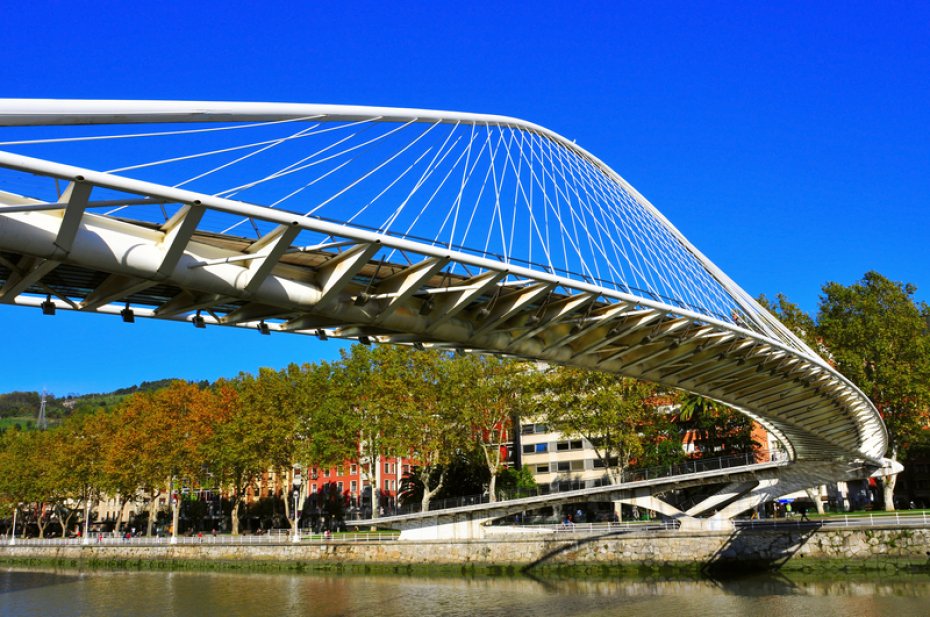Basque & Cantabria. Feb 1-3, 2019
I entered Spain from the Basque country and it continues for much of northern Spain. With three local languages to deal with (French, Basque and Spanish), English gets left out. All the main road signs are in Basque.
This is my second visit to the area. I drove 6300 km around Spain in 2010 after walking the Camino de Santiago.
Cape Higuer Lighthouse, Hondarriba. To the east of San Sebastian, this is a great place for views of the coast but is quite an out-of-the-way drive. The lighthouse can’t be visited. It is basically a square concrete base with a small octagonal tower.
A great trail, part of the GR121, centres on the lighthouse. A .9km trail goes down to the cape and then in the other direction continues for 20.9 km up over the mountain (954m) and descends to the port in San Sebastian. There is also a campground full of the usual park-model trailers.
SAN SEBASTIAN (pop 186,000, metropolitan 437,000) Called Donostia in Basque, it lies on the coast of the Bay of Biscay, 20 km from the French border. The main economic activities are commerce and tourism, and it is one of the most famous tourist destinations in Spain. Despite the city’s small size, events such as the San Sebastián International Film Festival have given it an international dimension.
Despite appearances, both the Basque form Donostia and the Spanish form San Sebastián have the same meaning as Saint Sebastian.
San Sebastián’s three picturesque beaches, Concha, Ondarreta, and Zurriola, make it a popular resort. The town is surrounded by easily accessible hilly areas and sits at the mouth of the River Urumea – the city was built to a large extent on the river’s wetlands over the last two centuries.
It has an oceanic climate with warm summers and cool winters and cloudy or overcast conditions for the majority of the year, typically with some precipitation (1,650 mm – 65 in) of precipitation annually fairly evenly spread throughout the year.
In 1813, after a siege of various weeks, the British ransacked and burnt the city to the ground.
The Old Part is neoclassical and austere in its architectural construction. In 1863, the defensive walls of the town were demolished. The Spanish Civil War saw over 600 individuals murdered and 40,000 to 50,000 inhabitants left. In the aftermath of war, the city was stricken by poverty, famine and repression, coupled with thriving smuggling.
The massive immigration from various parts of Spain, spurred by growing industrial production, greatly increased population but social, cultural and political contradictions and inequities followed and Basque nationalists triggered in 1968 the first state of emergency in Gipuzkoa.
Donostia is renowned for its Basque cuisine. San Sebastián and its surrounding area is home to a high concentration of restaurants boasting Michelin stars including Arzak (San Sebastián), Berasategi (Lasarte), Akelarre (district Igeldo) and Mugaritz (Errenteria), to mention but a few. It is the second city with the most Michelin stars per capita in the world, only behind Kyoto, Japan. Adding to these cooking highlights, the city features tasty snacks similar to tapas called pintxos, which may be found at the bars of the Old Quarter.
Donostia-San Sebastián has become an important University town. Four universities and a superior conservatory are present in the city.
Funicular de Igueldo. Traveling 320 metres, the funicular connects Ondarreta Beach at the bottom, with the popular Monte Igeldo Amusement Park at the top, offering spectacular coastal views of La Concha Bay along the way. Located on the side of a cliff face, it has two carriages carrying passengers both up and down on a single track with a passing loop at the midpoint.
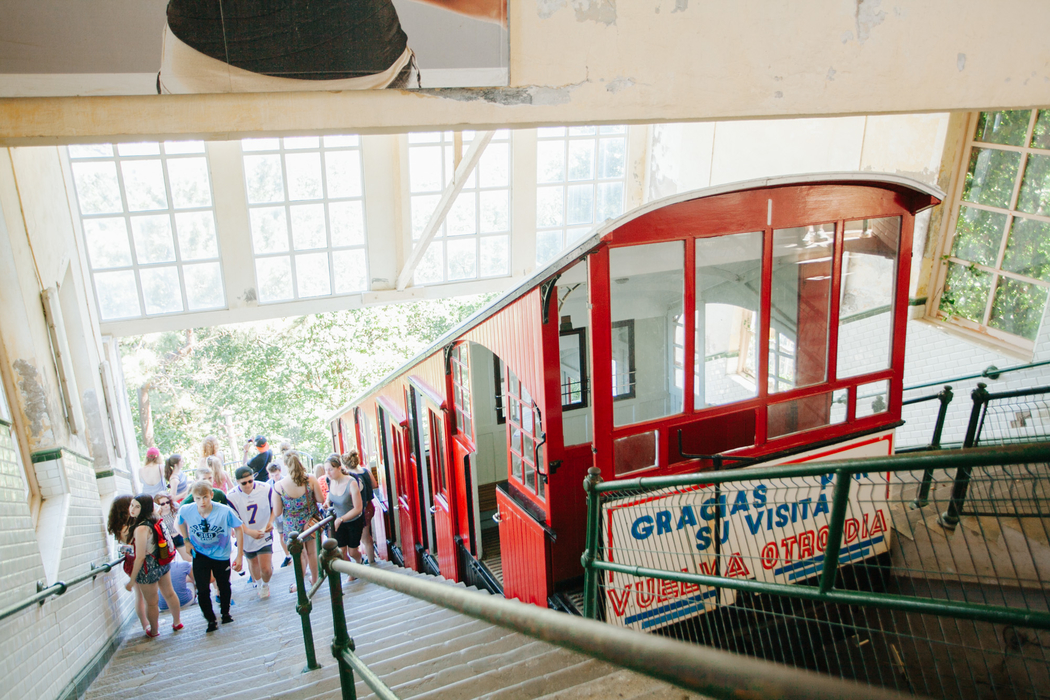
San Telmo Museum. Housed in the wonderful San Telmo Convent in the centre of the old city, this is the museum to visit for Basque culture. There is enough English to get by. The temporary exhibits on ‘The Body” and the ‘Lion of Arrkritz’, found in a cave nearby is the most complete skeleton of this extinct lion, once in Eurasia and Alaska, which were both excellent. The 11 wonderful frescoes in the church done in 1929, cover 784 sq.m of wall and are worth the admission price alone. They illustrate the most important parts of Basque history. The upper floors have Basque culture and 2 galleries of mostly local art. €3 reduced.
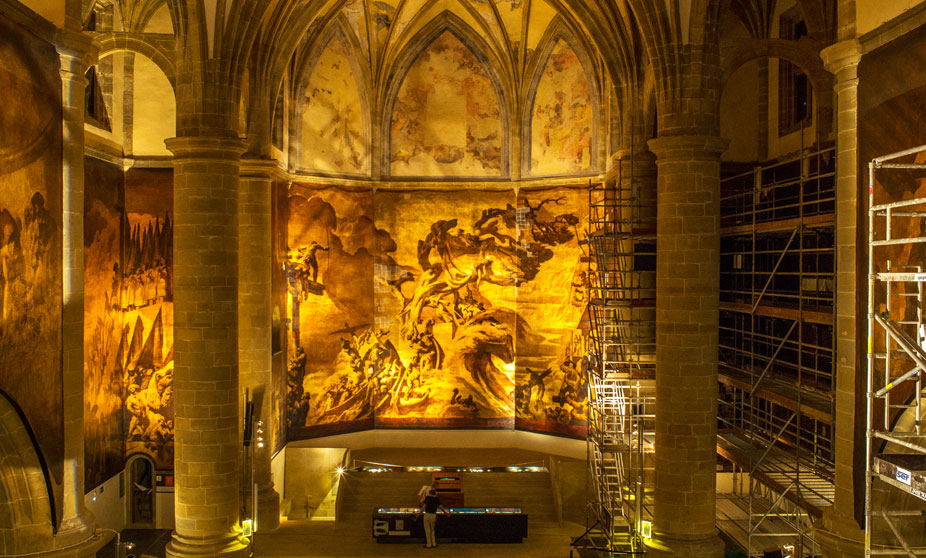
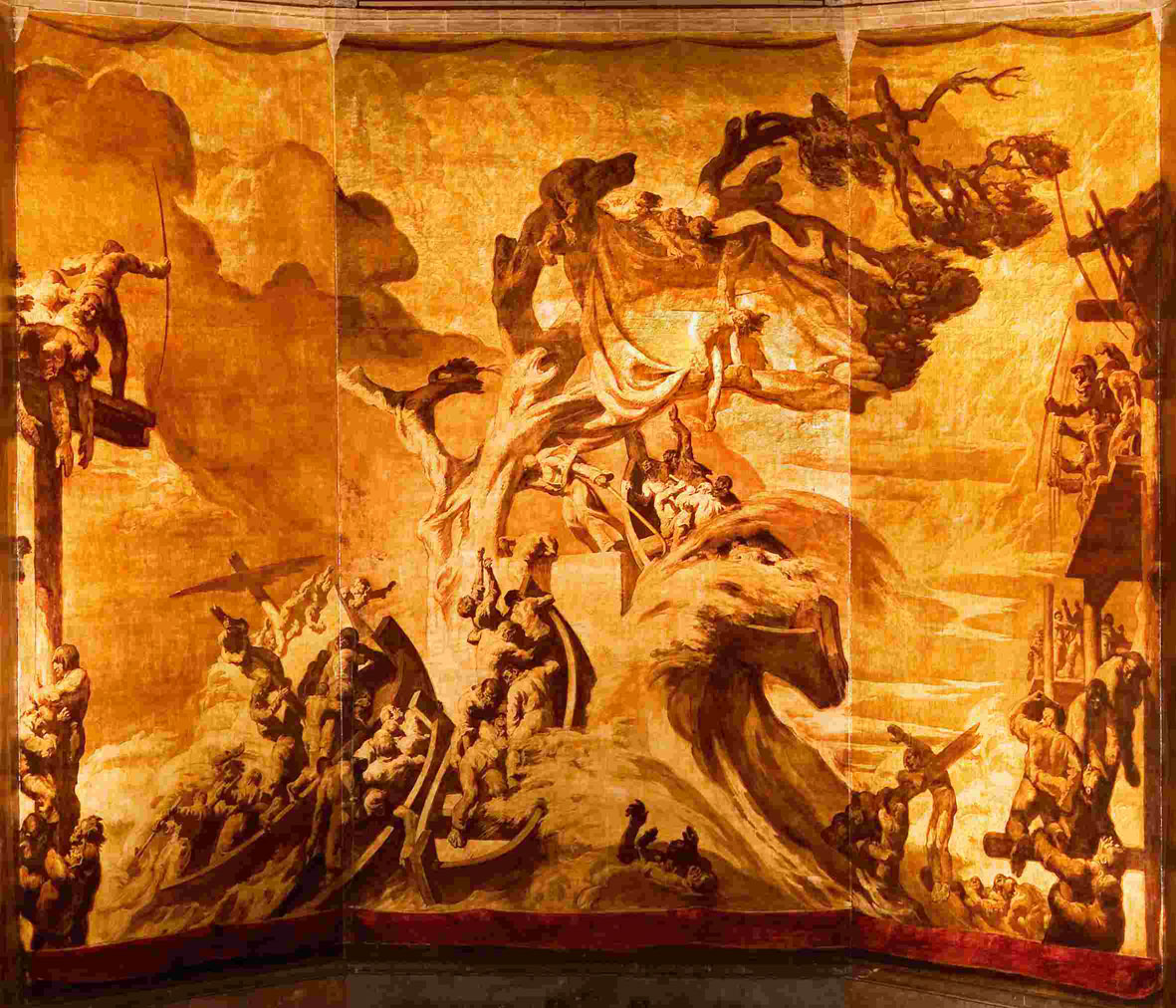
VIZCAYA BRIDGE is a transporter bridge that links the towns of Portugalete and Las Arenas, crossing the mouth of the Nervion River. People in the area, and even the official website, commonly call it the Puente Colgante (literally “hanging bridge”, used for a suspension bridge in Spanish), although its structure is quite different from a suspension bridge.
It is the world’s oldest transporter bridge and was built in 1893. It was the solution given by the engineer to the problem of connecting the towns without disrupting the maritime traffic of the Port of Bilbao and without having to build a massive structure with long ramps. Palacio wanted to design a bridge that could transport passengers and cargo. The service was only interrupted once, for four years, during the Spanish Civil War, when the upper section was dynamited.
In 2006, the Vizcaya Bridge was declared a World Heritage Site by UNESCO, the only Spanish monument in the Industrial Heritage category, a perfect combination of beauty and functionality. It was the first to use a combination of iron technology and new steel cables which began a new form of constructing bridges which were later imitated throughout the world.
The bridge, still in use, is 164 meters long, and its gondola can transport six cars and several dozen passengers in one and a half minutes. It operates every 8 minutes during the day (every hour at night), all year round. An estimated four million passengers and half a million vehicles use the bridge annually.
There are two new visitor lifts installed in the 50-metre-high pillars of the bridge that allow walking over the bridge’s platform, from where there is a superb view of the port and Abra Bay.
The structure is made of four 61-metre towers which are pillars and stand on the river banks. The towers are braced by cables into the hill or ground behind. The upper crossbeam rests between two towers by 70 suspension cables. The gondola transports vehicles and they hang from a 36-wheeled city and are 25m. long. It moves along the rails through the horizontal crossbeam. €1 passenger and €3 for cars.

There is a list of similar bridges in the world, but only a few remain: Middleborough England (1914, 177m) and Rochefort France (1900, 140m). There were others in Brest, Runcon, Duluth, Marseille, Rensburg, Osten, Buenos Aires and Warrington.
BILBAO (pop 345,000)
Guggenheim Museum. A wonderful piece of architecture, I visited it in 2010. The aluminum-clad building, designed by the Canadian, Frank Gehry, is well worth seeing but the art inside is not so great.
Iberdrola Tower is an office skyscraper (2009-2012) with a height of 165 metres (541 feet) tall and 40 floors. The first eight floors of the tower were to hold a hotel by the Spanish hotel chain ABBA, but the project was eventually cancelled. The remaining floors have office usage. The tower, built as Iberdrola’s headquarters, is the tallest building in the Basque Country and the city of Bilbao, and the eighth tallest building in Spain.
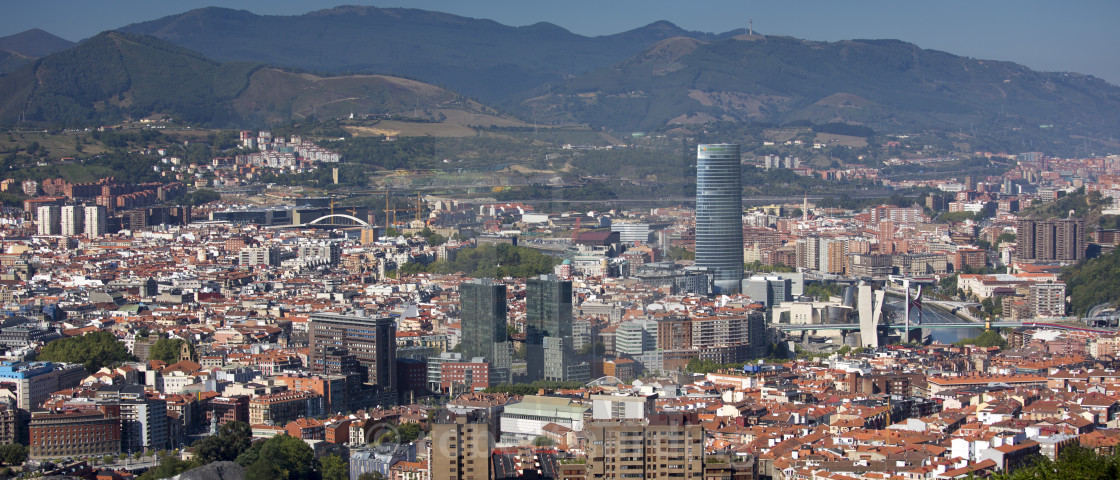 Basque Archaeological, Ethnographic and Historical Museum. Another Basque museum, I would see the one in San Sebastian. €6
Basque Archaeological, Ethnographic and Historical Museum. Another Basque museum, I would see the one in San Sebastian. €6
Molina Aixemota. This windmill could not be found.
Maritime Museum Ria. Basically, under a roundabout on the west side of the river, this details the role of the Basque country in naval history.
Museo de Reproducciones Artisticas. This is a classical art gallery with copies of the originals.
Zubizuri Bridge. (Basque for “white bridge” also called the Campo Volantin Bridge or Puente del Campo Volantin) is a tied arch footbridge across the Nervion River linking the Campo Volantin right bank and Uribitarte left bank of the river offering a convenient route from hotels to the nearby Bilbao Guggenheim Museum. Opened in 1997, the bridge’s unusual design consists of a curved walkway supported by steel suspension cables from an overhead arch. It is painted white and the bridge deck consists of translucent glass bricks that are locally infamous for becoming slippery in the wet climate of the city. Replacing broken glass tiles costs 6,000-25,000 euros a year (depending on no the source).
The good weather did not last long. During the night there was another big rainstorm with high winds and lightning, but it never went below 6°C. I stayed at a McDonald’s with massive crowds, 10-15 cars in the drive-through and the place crowded with teenagers and 20-somethings until well after midnight. The prices are extreme by North American standards.
The weather was very unsettled as a massive storm rolled through dropping snow as it went. I was in and out of the storm all day.
La Arboleda. About 20 km west of Balbao, climb high into the hills to this town founded in 1877 to house miners coming from all corners of the Iberian Peninsula. The town’s grid organization with parallel and perpendicular streets extending outwards from the main church (La Magdalena, 1896), features wooden houses and a stunning landscape dotted by lakes created at the site of the old mines which surrounded the town. The old miners’ hospital dates back to the 1890s. The iron-stained, rocky cliffs are full of old mines.
It is part of the World Heritage Site “Mining Historical Heritage” comprised of 17 mining districts throughout Spain.
The Basque sites consist of:
1. Las Encartaciones iron ore mines. Iron-ore mining occurred in the Basque Country from the 14th century until the end of the 16th ~ century and then again in the 18th century thanks, in part, to the development of the steel industry. In the middle of the 19th century, the first blast furnaces were installed, marking the beginning of renewed iron exports to the United Kingdom. The intense industrialization of the Basque Country gave rise to steel production which used the iron from its Vizcaya and Guiplizcoa mines, also sparking an important machinery and tool industry.
There remain ore baking kilns, rail and elevated ore transport lines using a bucket system, inclined planes and loading docks on the shores of the Cantabrian Sea and the Ne~i6n Estuary.
Housing was built for miners, office buildings, miners’ hospitals and the mines themselves. Abanto-Zierbena is home to quintessential mining towns and neighbourhoods such as Gallarta, Putxeta, Triano, La Balastera and Las Calizas. Trapagaran is home to the jewel of all mining towns, La Arboleda.
Valle Salado de Añana. About 12 km west of the highway, the road climbed over a moderate pass with at least 10 cm of snow. This tiny village is the oddest site, below and south of the village, the small valley is full of small (3m square) salt pans supported by brick and wood structures.
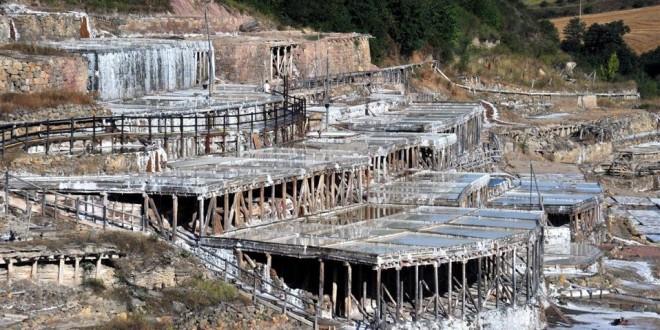
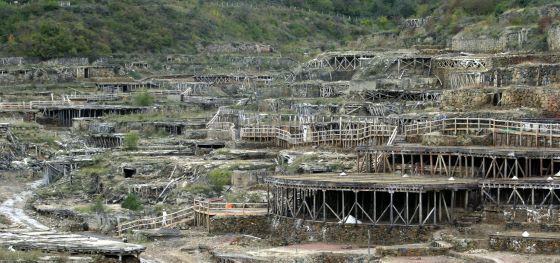
Also part of the Mining Historical Heritage, this is the UNESCO description of the area.
Aiiana salt mines. The geological salt dome formation is 5.5 X 3km. The “Salt Valley” comprised of springs, roads, canals, wells, solar evaporation sites and warehouses. Salt was produced by channelling spring water and water from the Muera River through a network of wooden aqueducts to an area of horizontal platforms made of wood and stone (owing to the slope of the terrain) called “farms” where the water was distributed into rectangular plots or solar evaporation sites. Once the water has evaporated, salt is harvested and stored in bins protected from the rain.
VITORIA-GASTEIZ
This is the seat of government and the capital city of the Basque Autonomous Community holding the House of Parliament, the headquarters of the Government, and the Lehendakari’s (Prime Minister’s) official residency. The municipality includes agricultural lands of 63 villages around.
Vitoria-Gasteiz is a multicultural city with strengths in the arts, commerce, education, healthcare, architectural conservation, aeronautics, vehicle industry, enology and gastronomy and is consistently ranked as one of the 5 best places to live in Spain. The old town holds some of the best-preserved medieval streets and plazas in the region and it is one of the very few cities to hold two Cathedrals. Vitoria-Gasteiz’s vicinity is home to world-renowned wineries.
Artium Museum. Off the town square, this contemporary art museum has some interesting pieces in the relatively exhibition space two floors down. Everyone here spoke English. By donating €2
Fournier de Naipes Museum. Closed from 2-4 pm, I waited quite a while for the 4 pm opening. The new building has archaeology from prehistory to medieval times on 3 floors, and an unusual exhibition of playing and tarot cards (with their printing presses) in the Palace de Bendaña, connected on the 3rd floor. Free
LA RIOJA
I then drove south to Logrono. On the way, I visited some small towns, in the Nomad Mania “small town” series.
Sajazarra. This is one of those very cute small rural villages – all yellow stone and narrow cobbled streets. The 1171 Eglisa Parochial and an unusually small castle are on the east side of the town.

Briones. With many more modern buildings, the highlight is the old town sitting upon a hill. Ermita del Christo is a small octagonal church with a lovely gilt altar. On the town square is the Palacio Marques de San Nicolas with a free museum on Roija rural life and the highlight of the town, the Santa Maria de la Asuncion church. Its gothic spire can be seen for miles. Inside the columns reach to the roof so there are no arches. There are three large gilt altars, the centre with Mary and the baby Jesus. The one on the right has a grand wood carving of Santiago Matamoros on his horse.
On the east side of town is a wine museum.
Laguardia sits on a hill and is surrounded by a wall with still preserved five entries to access the city, but it is pedestrian-only with very narrow cobble streets giving it a true medieval atmosphere. Its main economy is the wine industry, like everything else here.
Hotel Maques de Riscol, Elciego. This luxury hotel sits behind a big wall with several locked gates that hide the view of the spectacular hotel with several aluminum-clad “wings” that seem incredibly out of place where everything else is ancient. Designed by Frank Gehry, it used methods previously used in the Guggenheim Museum Bilbao.
On another snowy day with temperatures just above zero, I continued on my way to Madrid.
LOGROÑO (pop 155,000)
The capital of the province of La Rioja, it is on the Ebro River, 384 metres above sea level. The city is a centre of the trade in Rioja wine, for which the area is noted, and produces wood, metal and textile products. The Camino de Santiago passes through the city. It is 152 km from Bilbao, 172 km from Zaragoza, 336 km from Madrid and 468 km from Barcelona.
History. Logroño was an old settlement, first of the Romans, under the name of Vareia, a commercial port, and then of the Celts. From the 10th century, possession of Logroño was disputed between the kings of Navarre and those of Castile; the region was finally annexed to Castile. The name is a combination of le and Groin, mashed together as Logroño over time. In 1609 and 1610 Logroño was the main seat of the Basque witch trials, part of the Spanish Inquisition.
Logroño is the shopping and financial capital of La Rioja. Its economy is heavily reliant on wine. There are over 50 taperías (tapas restaurants) located within a four-block area near the town centre. The traditional tapas restaurants often serve only one tapa [such as seta (mushroom), served as pincho – pintxo in Basque.
Museo de la Rioja. In the old town, an 18th-century house exhibits the art, history and ethnography of La Rioja. €3 reduced
Santa Maria de Real El Monasterio, Najera. The Romanesque oldest parts of the church were restored in the 15th to 17th centuries. Inside the entrance to the cave is where the virgin appeared before King Garcia to start the Royal Pantheon of the Monarchs of Navarre with 12 tombs of kings from between 918-1076. The Pantheon of Infants has 14 tombs. The highlights are the 1493 choir stalls with marvellous carvings, the 1692 opulent main altar with Saint Mary and the lower cloister, the oldest area of the convent with great screens. In the cave is a 13th-century polychrome Virgin with the child Jesus. €4 reduced


Bahrami.jpg)
LOS MONASTERIAS SAN MILLAN YUSO AND SUSO. These two monasteries located in the town of San Millán de la Cogolla on the Cárdenas River comprise one UNESCO World Heritage Site. Yuso (below), as opposed to the one above (Suso). Suso is smaller, about 1km away and 200m higher – because of snow the bus couldn’t go there. The monastery can only be seen by guided tours in Spanish. I was the only one there and was given a private tour in English. €5
History. This monastery was built in 1053 by King García Sánchez III of Navarre. The history of its foundation is linked to a legend based on a miracle of San Millán or Emiliano (473-574), a young shepherd who becomes a hermit. He was ordained a priest who handed out miracles, and charity bread without caring who it was. When Millán died in 574, at the age of 101, his disciples buried him in his cave, and around it the first monastery was formed, that of San Millán de Suso and monks and pilgrims flocked to Suso. The monks copied codexes and provided the Court with scribes and Yuso Monastery was finished in 1067 to provide more space. The church was built between 1504-1540 and the best closer painters produced the 8 canvases present.
The Navarrese king García III was very devoted to San Millán. The monastery had about 120 monks in the 16th and 17th centuries, now there are only 10, all but one in the 70s. Originally Benedictine, in 1878 it was occupied by the friars of the Order of Augustinian Recollects. The monastery was totally rebuilt in the 16th century.
Hall of the Kings. It receives this name from the four canvases of benevolent kings of the monastery from 1697. It is the last great construction of the Benedictine abbots. In this room is the reproduction of the codex 60, one of the first times the language of the people (Spanish and Basque) was written down.
The 1549 cloister on the ground floor is also known as the processional. The cloister on the upper floor has twenty-five paintings by José Bejes that narrate the different miracles of San Millán and a nice collection of photographs of the local population from the early 1900s. A side room has the Songs of the XVII century, about 30 giant books, weighing between 40 and 60kg each, hand-made during four years of work and for which parchment was used from fragments of the skin of about 2000 cows. They contain the complete collection of all the songs that the monastic community prays throughout the year. It is one of the four complete collections that are conserved in Spain.
The Church (1504-40) was only for the use of the monks: 1640 choir stalls had a large book support where the huge books of music were placed to be sung by the choir, first one side then the other; altarpiece central painting represents San Millán in the battle of Hacinas (Burgos) against the Moors. The Christians, in their struggles against the Muslims, chose San Millán as a patron.
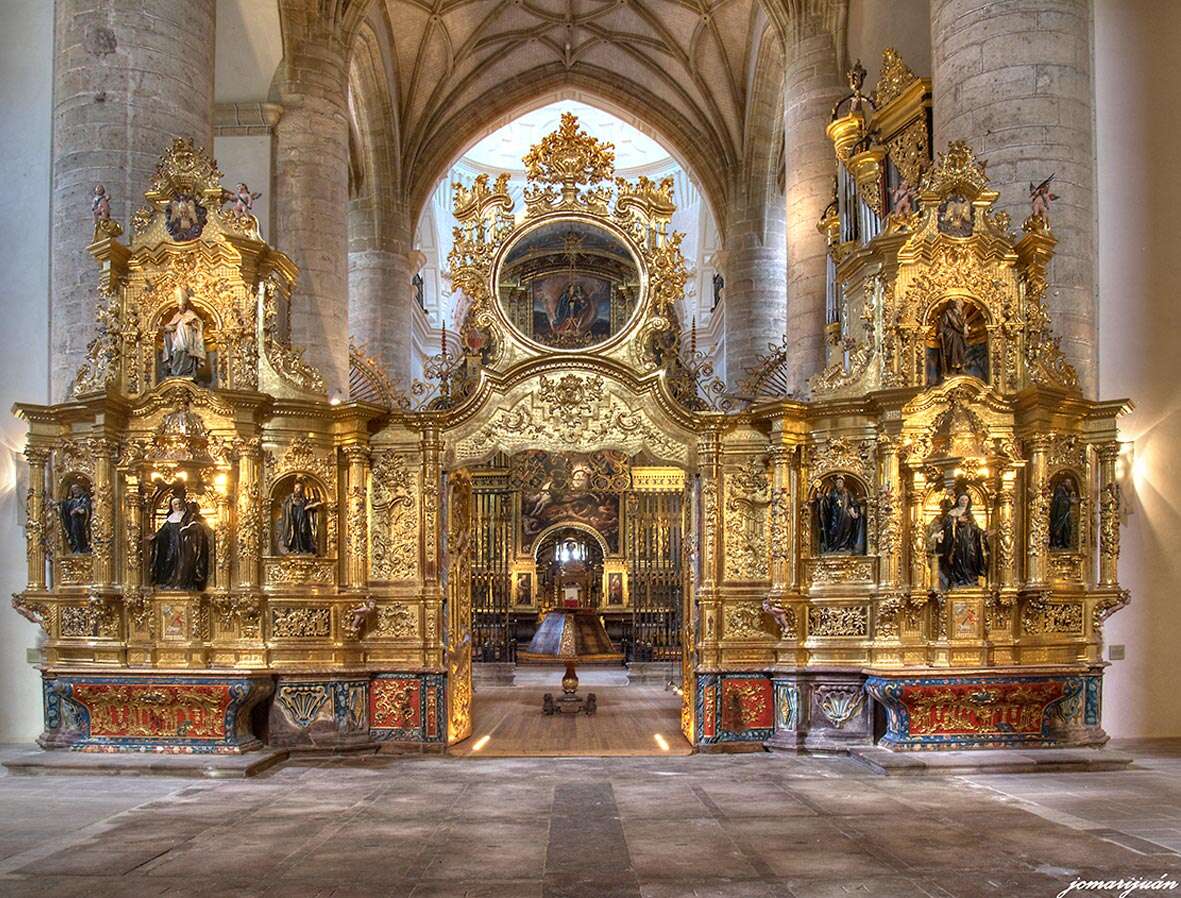
Parochial Church was where the people of the town went to church. It has a wonderful pulpit with great carvings of the four evangelists.
Oratory has the monastery’s greatest treasures, the reliquary coffers of the San Millán (11th century) and its master San Felices (12th century) covered in great ivory carvings, thirteen of the life of San Millán.
.jpg)

Sacristy is the artistic highlight with 17th-century frescoes on the ceiling, 1000kg marble tables, twelve copper paintings and four large canvases.
Archaeological Atapuerca. A karstic hill formation near the village of Atapuerca was excavated finding rich fossils and stone tools which are attributed to the earliest known hominin residents in Western Europe plus from a broad time range of early humans, hunter-gatherer groups to Bronze Age occupants and modern human settlers.. The Atapuerca Mountains served as the preferred occupation site of Homo erectus, Homo antecessor (or Homo erectus antecessor), Homo heidelbergensis and Homo neanderthalensis communities. The earliest specimen so far unearthed and reliably dated confirms an age between 1.2 Million and 630,000 years. Some finds are exhibited in the nearby Museum of Human Evolution in Burgos. The site was designated a UNESCO World Heritage Site.
Google Maps had huge problems here. I did not know where the museum was (just east of the town about 1km off the right to the north), somehow missed it on my first drive-by and in typical Google Map fashion directed me in a huge drive-about on narrow roads covered in snow and ice for about 25 km when it was only 2 km away in the other direction. Take a wrong turn and it instantaneously gives a new route continuing in the wrong direction instead of simply saying “Make a U-turn”. This redirection is important on one-way roads, especially divided highways but is kind of useless everywhere else. This is not the first time this has happened.
Around Atapuerca I crossed several pilgrims walking in the snow.
BURGOS (pop 180.000)
The historic capital of Castile, it is situated on the confluence of the Arlanzón river tributaries, at the edge of the Iberian central plateau. The Burgos Laws first governed the behaviour of Spaniards towards the natives of the Americas were promulgated here in 1512.
It has many historic landmarks, of particular importance; the Cathedral of Burgos (declared a World Heritage Site by UNESCO in 1984), and the seat of the Metropolitan Roman Catholic Archdiocese of Burgos. Castilian nobleman, military leader and diplomat El Cid Campeador is a significant historical figure in the city, as he was born a couple of kilometres north of Burgos and was raised and educated here (his great tomb is in a central position in the church. A large number of churches, palaces and other buildings from the medieval age remain.
The Museum of Human Evolution was opened in 2010, unique across the world and projected to become one of the top 10 most-visited museums in Spain. The museum features the first Europeans, who lived in this area 800,000 years ago. €5 reduced
Burgos Museum. A typical local museum showing the history and local culture. Free
This was my third visit to Burgos – the first when I walked the Camino Frances and then 1 month later when I drove 6300 km around Spain.
PALENCIA (pop 78,000)
It is the capital of the province of Palencia in Castile and León. Palencia is located approximately 190 km north of Madrid, and some 40 km north of Valladolid, capital of Castile and León. Two hills surround the city in its northeast area. On the closest stands the 30-metre-high statue of Christ known as the Cristo del Otero, the fourth tallest statue of Christ in the world.
History. The city was starved into submission by the Romans in the 2nd century BC and incorporated into the province of Hispania Tarraconensis, Though the little Roman garrison city was an active mint, it was insignificant compared to the Roman villas in the surrounding territory. The city was all but destroyed (457) in the Visigothic wars against the Suevi.
Cathedral de Palencia. The Catholic bishopric of Palencia was founded in the 3rd century. The original cathedral was built over the crypt of the local Saint Antolín (Antoninus of Pamiers) and rebuilt again three centuries later. Its principal treasures were relics of Antoninus, formerly venerated in Aquitania, whence they had been brought. The flamboyant Gothic Cathedral was built from 1321 to 1504 and dedicated to San Antolín.
VALLADOLID (pop 309,000)
The capital of Castile and León, it is northwestern Spain’s biggest city. Valladolid was originally settled in pre-Roman times by the Celtic Vaccaei people, and later the Romans themselves. It remained a small settlement until being re-established by King Alfonso VI of Castile as a Lordship and grew to prominence in the Middle Ages as the seat of the Court of Castile and being endowed with fairs and different institutions as a collegiate church, University (1241), Royal Court and Chancery and the Royal Mint.
Christopher Columbus died in Valladolid in 1506. After the early 1600s, the city declined until the arrival of the railway in the 19th century, and with its industrialization into the 20th century.
National Museum of Sculpture.
Museum of Contemporary Art Patio Herreriano
Oriental Museum
Museo Casa Cervantes. The building was the home of the Spanish author Miguel de Cervantes and is not to be confused with other houses associated with Cervantes, the birthplace in Alcala de Henares and the museum in Esquivias. Cervantes lived here in 1605 when there was a tavern on the ground floor. Only women were living with him: his wife Catalina, his very religious (“beata”) sister Magdalena, a seamstress for wealthy gentlemen, his sister Andrea, also a seamstress, her illegitimate daughter Costanza, Cervantes’ illegitimate daughter Isabel, and a maid named María. It is well documented in the testimony that prostitution was taking place in the house, but the identity of the prostitutes was never clarified. There were suspicions that among them may have been some of the women in Cervantes’ household. €3
SEGOVIA (pop 57,000)
History. The first recorded settlement was Celtic and then became Roman. It is believed that the city was abandoned after the Islamic invasion of Spain centuries later. Segovia’s position on trading routes made it an important centre of trade in wool and textiles. The end of the Middle Ages saw a golden age for Segovia, with a growing Jewish population and the creation of a foundation for a powerful cloth industry.
In 1985 the old city of Segovia and its Aqueduct were declared World Heritage Sites. The old city contains a multitude of historic buildings both civil and religious, including a large number of buildings of Jewish origin, notably within the old Jewish Quarter.
The Aqueduct of Segovia is the defining historical feature of the city, dating from the late 1st or early 2nd century CE and remains one of the extraordinary engineering accomplishments existing in the country because of its long span, architectural beauty, uncharacteristic slenderness, and dramatic presence in the centre of a dense urban fabric – the most impressive Roman structure in Spain, and one of the most famous among the numerous aqueducts built by the Romans throughout their vast Empire. It consists of about 25,000 granite blocks held together without any mortar and spans 818 meters with more than 170 arches, the highest being 29 metres high.
Alcazar of Segovia, the royal palace built on a stone peninsula between the rivers Eresma and Clamores was documented for the first time in 1122 and was one of the favoured residences of the kings of Castile. The building is structured around two courtyards and has two towers and a keep. It now houses the General Militar de Segovia archive and museum of the Royal School of Artillery. It has wonderful rooms decorated in Islamic style including great Maquina ceilings above carvings. €3 reduced, €2 to climb the tower.
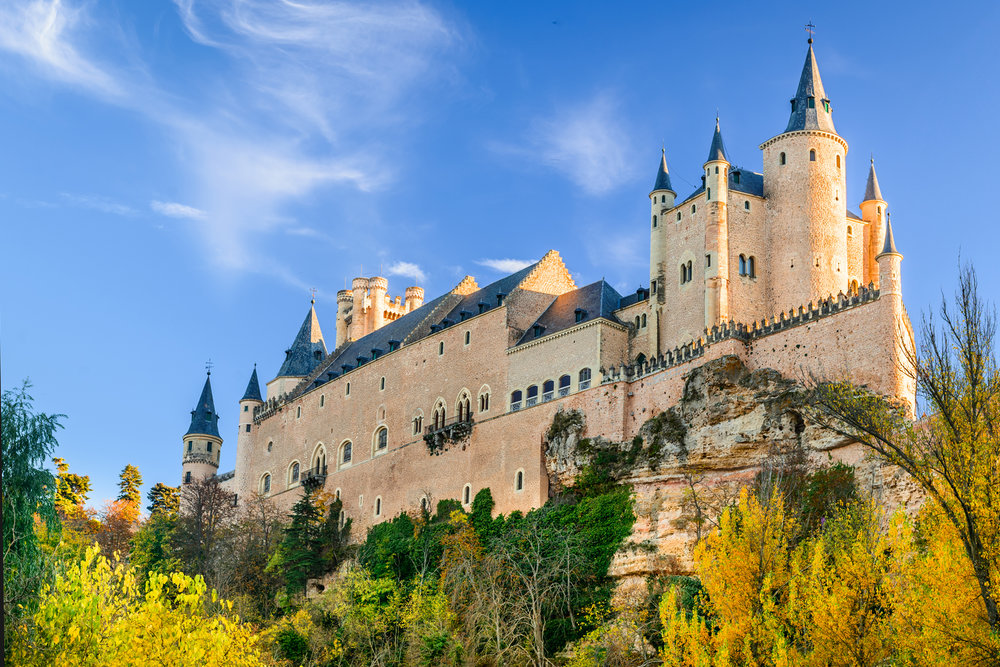

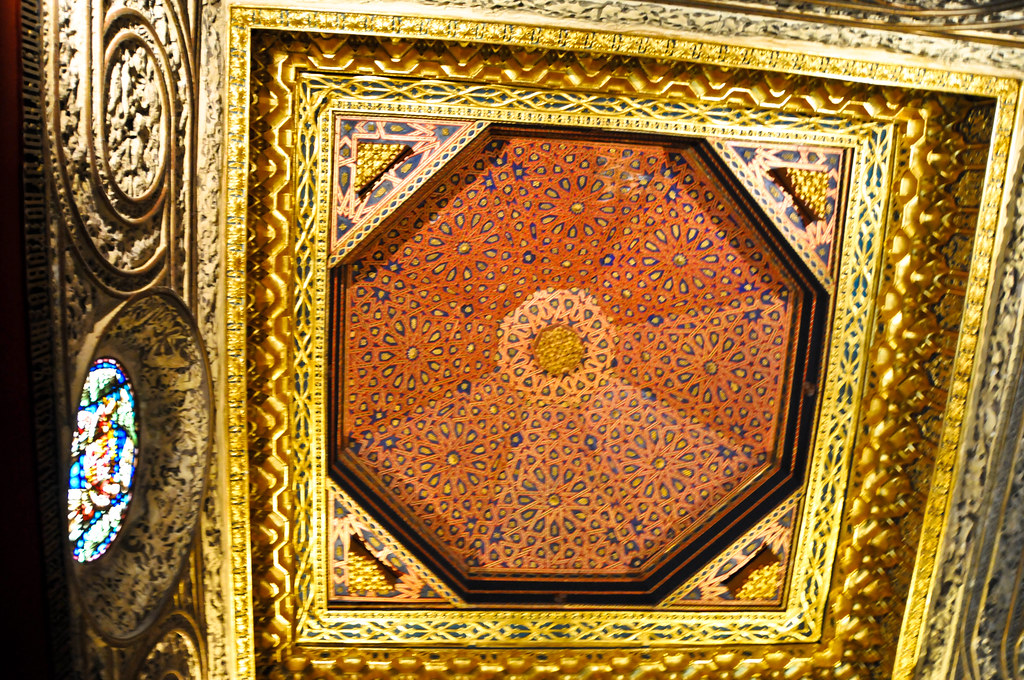
Segovia Cathedral, the last Gothic cathedral built in Spain, it is considered a masterpiece of Basque-Castilian Gothic architecture and is known as “The Lady of Cathedrals. It was consecrated in 1768 and is 105 meters long, 50 metres wide and 33 m high in the nave, has 18 chapels and three doors.
This is my second time in Segovia and I saw everything again.
Royal Palace of La Granja de San Ildefonso is an early 18th-century palace in the small town of San Ildefonso, located in the hills 15 km SE of Segovia and 80 kilometres (50 mi) north of Madrid. It became the summer residence of the Kings of Spain from the 1720s during the reign of Philip V. The palace is in a restrained Baroque style. It is now open to the public as a museum and is a popular tourist attraction, with gardens, and interiors displaying rooms with marble from Carrara, Japanese lacquer, and crystal chandeliers; portraits and other paintings; and a Museum of Flemish tapestries.
Extending over 1,500 acres (6.1 km2), the gardens around the palace are one of the best examples of 18th-century European garden design in the Jardin à la française style in Spain. Sculptors arrived from Paris to execute designs on the site. All of the fountains represent themes from classical mythology cast in lead to prevent corrosion, and painted over to simulate bronze,
The “Baths of Diana” fountain is the focal point of several garden alleés, and was made from lead and then painted to look like bronze and marble. It and its marble statues form some of the most impressive and well-conserved architecture from this period in Spain. The original waterworks and piping are still functional and rely purely on gravity to project water up the fountain jets, including to the 40 metres (130 ft) height of the “Fame” fountain. A reservoir, El Mar (the Sea), lies secluded at the highest point of the landscape park and provides the supply and water pressure for the whole system. Only a few fountains are active each day. Twice a year, on the feast days of San Fernando and of San Luis, all twenty-six fountains are set to jet and flow. €9, 5 reduced
